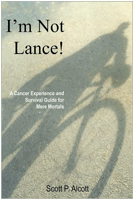I'm Not Lance! A Cancer Experience & Survival Guide for Mere Mortals
encontrar mi
Author: Scott P. Alcott
ISBN: 9781449986322
Information: CreateSpace Publishers, 2009 | $15.00 US | Paperback
OncoLinkRating:
Ahhhh, spring; here at last it's a classic end-of-March-first-week-of-spring sort of day: robins on the front lawn, yellow daffodils blooming in the backyard, the sun shining, brightly in a clear blue sky. Finally, after our record snowy winter, the season has truly changed. And without warning spring fever has hit me - smack - right between the eyes. I'm hungry for some Vitamin D therapy, so I grab Scott Alcott's book, head outside to the patio, stretch out on a chaise lounge and start reading.
I'm Not Lance! hooks me from the opening line (for my 40th birthday, I got stage four cancer...), and keeps me turning pages for 60 minutes or more, until I finish the final chapter and close the book with a satisfied smile on my face.
Here's what I now know for sure:
Author Scott Alcott, a husband, father of two and IT professional was diagnosed with Ewing's Sarcoma and endured treatment surgery, chemotherapy, radiation in a place he began calling Cancerville.
Along the way, like so many fellow cancer survivors, he received a copy (or two) of Lance Armstrong's book, It's Not About the Bike along with the iconic yellow Livestrong bracelet. Well-meaning friends and relatives hoped the gifts would support his recovery. However, once Alcott read Lance's memoir, he realized that he felt both inspired and ambivalent at the same time:
"...Could I measure up to him. He set the bar very high. I knew I didn't have Lance's bravery, stamina, pain tolerance, competitiveness, focus and physical gifts. I felt inadequate and ill-equipped for going into the same fight as him. Do I need to be like Lance Armstrong to beat this."
While Alcott never competes in the Tour de France like his hero Lance Armstrong, his memoir earns high praise for including helpful information and practical strategies for the cancer patient going through the rigors of treatment. He shares a wide and varied assortment of useful ideas. For example, Alcott created and maintained a three ring binder containing data relevant to his disease (including but not limited to contact information for all of the health professionals on his treatment team, copies of scans, pathology reports, op notes and treatment plans). Alcott carried his binder with him to each and every treatment session and office visit. Having all of that data organized, available and easily accessible was one way that he could exert some control and feel well-informed enough to take a proactive role in the decision-making process related to his treatment.
Alcott's book documents the ups and downs of being a frequent flyer in the healthcare delivery system. He speaks authentically about how these encounters are life-changing events. In fact, Alcott deserves an award for humility for his experiences repeatedly Googling his disease and bringing his findings to his oncologist. While his doctor always listened respectfully and spent considerable time explaining clinical aspects of his case in detail without getting defensive, ultimately the oncologist, not the Internet, was always right. As a result, a humbled Alcott finally recommends that:
"...Patients rely on the web only to guide questions and to improve understanding of what the doctors say. I strongly advise against using it to make conclusions especially about one's prognosis or the right treatment plan...Find an oncologist who you are comfortable with and let him help you with what it all means. They have medical school for a reason."
Another notable suggestion in the book is for cancer patients to remember to regularly express heartfelt gratitude to all of the members of the healthcare delivery system for their efforts in the treatment and recovery process. (Alcott's gift of choice. To-pof-the-line Belgian Marcolini chocolates).
Alcott also counsels cancer patients to keep a journal. But he goes beyond suggesting that patients write about what is happening and how managing a cancer diagnosis makes them feel. The author recommends the cancer survivors actually document their own physical changes by taking digital pictures of parts of their body undergoing changes during treatment.
I'm Not Lance! ends memorably with Alcott at his six month check-up, waiting nervously in the examining room for the doctor's predictable tap-tap on the door. It's what Alcott calls an "open door moment." He will look at the doctor's face as he enters the room and immediately know from the oncologist's expression whether the news is good or bad. In fact, the doctor is smiling broadly; the scan is clear
But what about Alcott's overarching question that begins his book. Do cancer patients have to measure up to Lance Armstrong to beat cancer. The author is clear about that as well:
I had just completed surgery, months of chemo and radiation that's three rounds in the ring with the world's meanest killer, and I was still standing...Maybe I'm not Lance, but I can take a punch too. Score one for the mortals...Maybe I've got a little bit of Lance in me after all. Maybe all of us mortals do.
All proceeds from I'm Not Lance! will be donated to the Liddy Shriver Sarcoma Initiative to improve the quality of life for people dealing with sarcoma.


